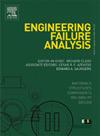海水环境下钛合金螺旋桨疲劳失效分析及腐蚀时间的影响
IF 5.7
2区 工程技术
Q1 ENGINEERING, MECHANICAL
引用次数: 0
摘要
船用钛合金螺旋桨在不同腐蚀时间下的试验研究是工程实践和理论探索的重要研究课题。通过设计疲劳试验,研究了TC4钛合金船用螺旋桨的疲劳行为及评价,发现腐蚀时间对螺旋桨失效机理及寿命评价具有不可忽视的不利影响。考虑腐蚀持续时间和表面划痕的综合影响,改进的Murakami模型可以很好地估计预腐蚀TC4的疲劳强度。对比分析表明,改进的Paris模型对TC4在不同腐蚀持续时间下的寿命预测具有最小误差范围的稳定性。通过扫描电镜(SEM)和电子背散射衍射(EBSD)进行的显微组织表征显示,随着腐蚀时间的延长,晶粒逐渐变粗,并伴有明显的解理和韧性断裂特征。EBSD成像显示,在低角晶界处存在明显的应变集中的粗大晶粒结构,且随着预腐蚀时间的延长,晶粒尺寸显著增大。这些发现阐明了TC4腐蚀与疲劳失效之间的机理关系,而提出的修正模型为推进船舶设备的疲劳研究提供了新颖而重要的工具。本文章由计算机程序翻译,如有差异,请以英文原文为准。

Fatigue failure analysis for marine propeller used titanium alloy under salty-water environment with the effect of corrosion durations
The experimental investigation on marine propeller used titanium alloy under varying corrosion durations represents a significant research issue in both engineering practice and theoretical exploration. This study focuses on fatigue behavior and evaluation for marine propeller used TC4 titanium alloy through designed fatigue testing that corrosion duration exerts a non-negligible adverse impact on the failure mechanisms and life evaluation. The modified Murakami model incorporating coefficient fr demonstrated suitability for estimating the fatigue strength of pre-corroded TC4 with the combined influence of corrosion durations and surface scratches. Comparative analysis of fatigue life prediction models indicated that the modified Paris model provides stable life estimations with minimal error margins for TC4 under different corrosion durations. Microstructural characterization through scanning electron microscopy (SEM) and electron backscatter diffraction (EBSD) revealed a progressive grain coarsening phenomenon correlated with extended corrosion durations, accompanied by distinct cleavage and ductile fracture characteristics. EBSD imaging reveals coarse grain structures with significant strain concentration at low-angle grain boundary are detected, and the grain size significantly increases with the increases of pre-corrosion duration. These findings elucidate the mechanistic relationship between corrosion and fatigue failure in TC4, while the proposed modified models offer novel and essential tools for advancing fatigue research in marine equipment.
求助全文
通过发布文献求助,成功后即可免费获取论文全文。
去求助
来源期刊

Engineering Failure Analysis
工程技术-材料科学:表征与测试
CiteScore
7.70
自引率
20.00%
发文量
956
审稿时长
47 days
期刊介绍:
Engineering Failure Analysis publishes research papers describing the analysis of engineering failures and related studies.
Papers relating to the structure, properties and behaviour of engineering materials are encouraged, particularly those which also involve the detailed application of materials parameters to problems in engineering structures, components and design. In addition to the area of materials engineering, the interacting fields of mechanical, manufacturing, aeronautical, civil, chemical, corrosion and design engineering are considered relevant. Activity should be directed at analysing engineering failures and carrying out research to help reduce the incidences of failures and to extend the operating horizons of engineering materials.
Emphasis is placed on the mechanical properties of materials and their behaviour when influenced by structure, process and environment. Metallic, polymeric, ceramic and natural materials are all included and the application of these materials to real engineering situations should be emphasised. The use of a case-study based approach is also encouraged.
Engineering Failure Analysis provides essential reference material and critical feedback into the design process thereby contributing to the prevention of engineering failures in the future. All submissions will be subject to peer review from leading experts in the field.
 求助内容:
求助内容: 应助结果提醒方式:
应助结果提醒方式:


